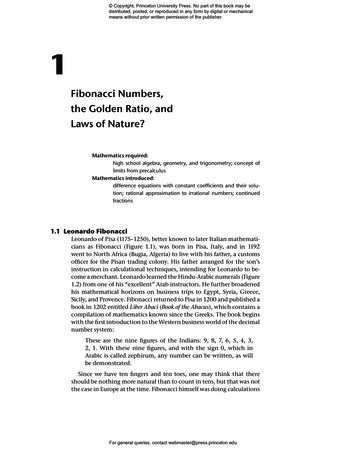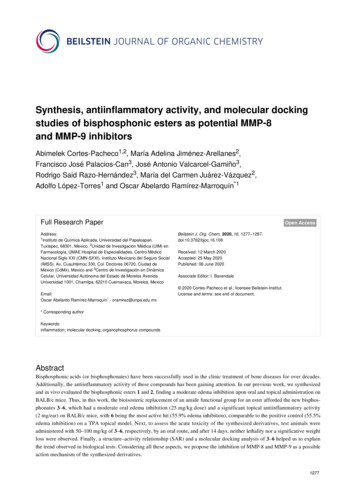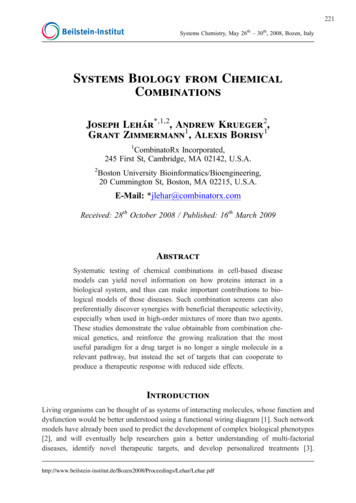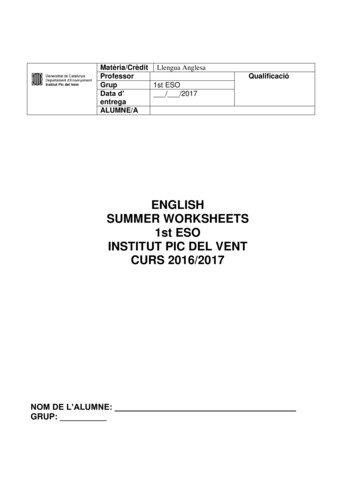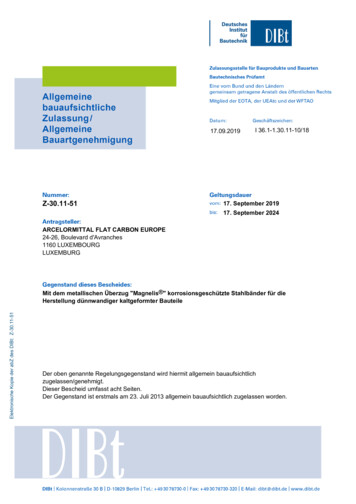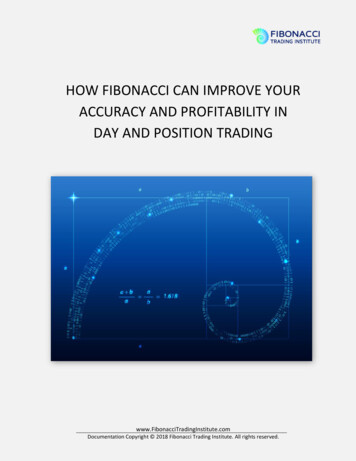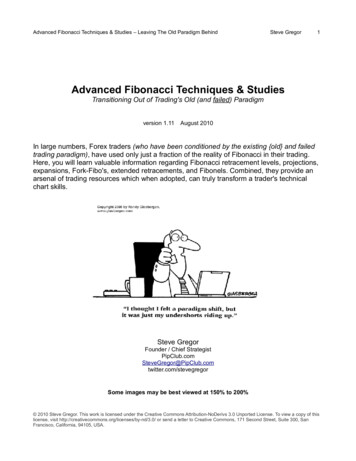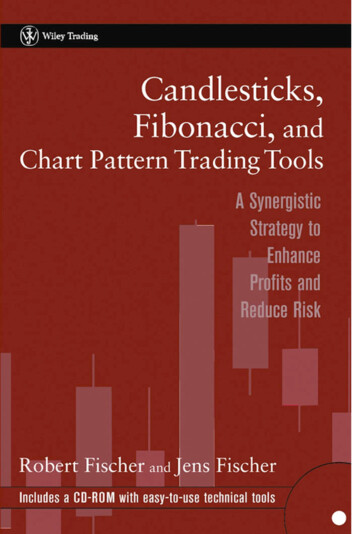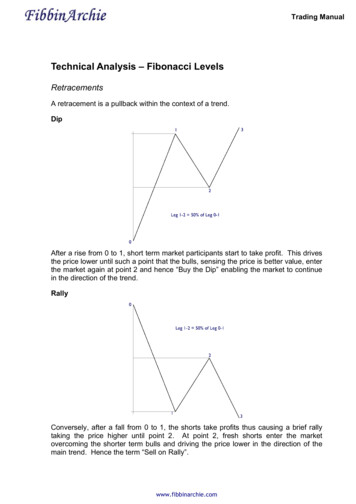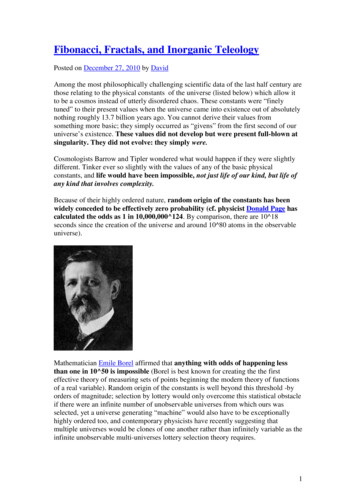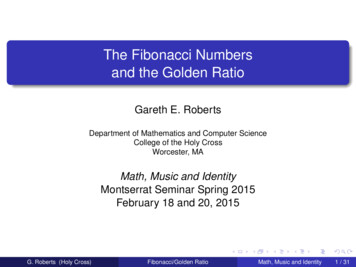
Transcription
Fibonacci Numbers and NatureThis page has been split into TWO PARTS.This, the first, looks at the Fibonacci numbers and why they appear invarious "family trees" and patterns of spirals of leaves and seeds.The second page then examines why the golden section is used bynature in some detail, including animations of growing plants.Contents of this PageTheicon means there is a Things to do investigation at the end ofthe section.Rabbits, Cows and Bees Family TreesFibonacci's Rabbits.Dudeney's CowsHoneybees and Family TreesFibonacci Numbers and the Golden NumberFibonacci Rectangles and Shell SpiralsFibonacci numbers, the Golden Section and plantsPetals on flowersSeed headsPine conesLeaf arrangementsLeaves per turnLeaf arrangements of some common plantsVegetables and FruitFibonacci Fingers?A quote from Coxeter on PhyllotaxisNavigating through this siteReferences and Links0, 1, 1, 2, 3, 5, 8, 13, 21, 34, 55, 89, 144, 233, 377,610, 987 .More.Rabbits, Cows and Bees FamilyTrees
Let's look first at the Rabbit Puzzle that Fibonacci wroteabout and then at two adaptations of it to make it morerealistic. This introduces you to the Fibonacci Numberseries and the simple definition of the whole neverending series.Fibonacci's RabbitsThe original problem that Fibonacci investigated (in the year 1202)was about how fast rabbits could breed in ideal circumstances.Suppose a newly-born pair of rabbits, one male, one female, are put ina field. Rabbits are able to mate at the age of one month so that at theend of its second month a female can produce another pair of rabbits.Suppose that our rabbits never die and that the female alwaysproduces one new pair (one male, one female) every month from thesecond month on. The puzzle that Fibonacci posed was.How many pairs will there be in one year?1. At the end of the first month, they mate, but there is still oneonly 1 pair.2. At the end of the second month the female produces a new pair,so now there are 2 pairs of rabbits in the field.3. At the end of the third month, the original female produces asecond pair, making 3 pairs in all in the field.4. At the end of the fourth month, the original female has producedyet another new pair, the female born two months ago producesher first pair also, making 5 pairs.
The number of pairs of rabbits in the field at the start of each month is1, 1, 2, 3, 5, 8, 13, 21, 34, .Can you see how the series is formed and how it continues? If not,look at the answer!The first 300 Fibonacci numbers are here and some questions for youto answer.Now can you see why this is the answer to our Rabbits problem? Ifnot, here's why.Another view of the Rabbit's Family Tree:
0, 1, 1, 2, 3, 5, 8, 13, 21, 34, 55, 89, 144, 233, 377,610, 987 .More.The Rabbits problem is not very realistic, is it?It seems to imply that brother and sisters mate, which, genetically,leads to problems. We can get round this by saying that the female ofeach pair mates with any male and produces another pair.Another problem which again is not true to life, is that each birth is ofexactly two rabbits, one male and one female.Dudeney's CowsThe English puzzlist, Henry E Dudeney (1857 - 1930, pronouncedDude-knee) wrote several excellent books of puzzles (see after thissection). In one of them he adapts Fibonacci's Rabbits to cows, makingthe problem more realistic in the way we observed above. He getsround the problems by noticing that really, it is only the females thatare interesting - er - I mean the number of females!He changes months into years and rabbits into bulls (male) and cows(females) in problem 175 in his book 536 puzzles and CuriousProblems (1967, Souvenir press):
If a cow produces its first she-calf at age two years and after thatproduces another single she-calf every year, how many she-calves arethere after 12 years, assuming none die?This is a better simplification of the problem and quite realistic now.But Fibonacci does what mathematicians often do at first, simplify theproblem and see what happens - and the series bearing his name doeshave lots of other interesting and practical applications as we seelater.So let's look at another real-life situation that is exactly modelled byFibonacci's series - honeybees.Puzzle books by Henry E DudeneyAmusements in Mathematics, Dover Press, 1958, 250 pages.Still in print thanks to Dover in a very sturdy paperback format at anincredibly inexpensive price. This is a wonderful collection that I find Ioften dip into. There are arithmetic puzzles, geometric puzzles,chessboard [uzzles, an excellent chapter on all kinds of mazes andsolving them, magic squares, river crossing puzzles, and more, all withfull soutions and often extra notes! Highly recommended!536 Puzzles and Curious Problems is now out of print, but you maybe able to pick up a second hand version by clicking on this link. It isanother collection like Amusements in Mathematics (above) butcontaining different puzzles arranged in sections: Arithmetical andAlgebraic puzzles, Geometrical puzzles, Combinatorial and Topologicalpuzzles, Game puzzles, Domino puzzles, match puzzles and"unclassified" puzzles. Full solutions and index. A real treasure.The Canterbury Puzzles, Dover 2002, 256 pages. More puzzles (notin the previous books) the first section with some characters fromChaucer's Canterbury Tales and other sections on the Monks ofRiddlewell, the squire's Christmas party, the Professors puzzles and soon and all with full solutions of course!Honeybees and Family treesThere are over 30,000 species of bees and in most of them the beeslive solitary lives. The one most of us know best is the honeybee andit, unusually, lives in a colony called a hive and they have an unusualFamily Tree. In fact, there are many unusual features of honeybeesand in this section we will show how the Fibonacci numbers count ahoneybee's ancestors (in this section a "bee" will mean a "honeybee").
honeybees such as: notFirst, someunusual factsaboutall of themhave two parents!In acolony of honeybees there is one special female called the queen.There are many worker bees who are female too but unlike thequeen bee, they produce no eggs.There are some drone bees who are male and do no work.Males are produced by the queen's unfertilized eggs, so male beesonly have a mother but no father!All the females are produced when the queen has mated with amale and so have two parents. Females usually end up as worker beesbut some are fed with a special substance called royal jelly whichmakes them grow into queens ready to go off to start a new colonywhen the bees form a swarm and leave their home (a hive) in searchof a place to build a new nest.So female bees have 2 parents, a male and a female whereas malebees have just one parent, a female.Here we follow the convention of Family Trees that parents appear above theirchildren, so the latest generations are at the bottom and the higher up we go, theolder people are. Such trees show all the ancestors (predecessors, forebears,antecedents) of the person at the bottom of the diagram. We would get quite adifferent tree if we listed all the descendants (progeny, offspring) of a person as wedid in the rabbit problem, where we showed all the descendants of the original pair.Let's look at the family tree of a male drone bee.1. He had 1 parent, a female.2. He has 2 grand-parents, since his mother had two parents, amale and a female.3. He has 3 great-grand-parents: his grand-mother had twoparents but his grand-father had only one.4. How many great-great-grand parents did he have?Again we see the Fibonacci numbers :
tNumber ofparents:parents:of a MALE bee:1of a FEMALE bee: 2grandparents:233558grand813The Fibonacci Sequence as it appears in Nature by S.L.Basinin Fibonacci Quarterly, vol 1 (1963), pages 53 - 57.0, 1, 1, 2, 3, 5, 8, 13, 21, 34, 55, 89, 144, 233, 377,610, 987 .More.Things to do1. Make a diagram of your own family tree. Ask your parents andgrandparents and older relatives as each will be able to tell youabout particular parts of your family tree that other's didn'tknow. It can be quite fun trying to see how far back you can go.If you have them put old photographs of relatives on a big chartof your Tree (or use photocopies of the photographs if yourrelatives want to keep the originals). If you like, include the yearand place of birth and death and also the dates of anymarriages.2. A brother or sister is the name for someone who has the sametwo parents as yourself. What is a half-brother and half-sister?Describe a cousin but use simpler words such as brother, sister,parent, child?Do the same for nephew and niece. What is a second cousin?What do we mean by a brother-in-law, sister-in-law, mother-inlaw, etc? Grand- and great- refer to relatives or your parents.Thus a grand-father is a father of a parent of yours and greataunt or grand-aunt is the name given to an aunt of yourparent's.Make a diagram of Family Tree Names so that "Me" is at thebottom and "Mum" and "Dad" are above you. Mark in "brother","sister", "uncle", "nephew" and as many other names of (kindsof) relatives that you know. It doesn't matter if you have nobrothers or sisters or nephews as the diagram is meant to showthe relationships and their names.[If you have a friend who speaks a foreign language, ask themwhat words they use for these relationships.]
3. What is the name for the wife of a parent's brother?Do you use a different name for the sister of your parent's?In law these two are sometimes distinguished because one is ablood relative of yours and the other is not, just a relativethrough marriage.Which do you think is the blood relative and which the relationbecause of marriage?4. How many parents does everyone have?So how many grand-parents will you have to make spaces for inyour Family tree?Each of them also had two parents so how many great-grandparents of yours will there be in your Tree?.and how many great-great-grandparents?What is the pattern in this series of numbers?If you go back one generation to your parents, and two to yourgrand-parents, how many entries will there be 5 generations agoin your Tree? and how many 10 generations ago?The Family Tree of humans involves a different sequence to theFibonacci Numbers. What is this sequence called?5.Looking at your answers to the previous question, your friendDee Duckshun says to you:o You have 2 parents.o They each have two parents, so that's 4 grand-parentsyou've got.o They also had two parents each making 8 great-grandparents in total .o . and 16 great-great-grand-parents .o . and so on.o So the farther back you go in your Family Tree the morepeople there are.o It is the same for the Family Tree of everyone alive in theworld today.o It shows that the farther back in time we go, the morepeople there must have been.o So it is a logical deduction that the population of the worldmust be getting smaller and smaller as time goes on!Is there an error in Dee's argument? If so, what is it? Ask yourmaths teacher or a parent if you are not sure of the answer!0, 1, 1, 2, 3, 5, 8, 13, 21, 34, 55, 89, 144, 233, 377,610, 987 .More.
Fibonacci numbers and theGolden NumberIf we take the ratio of two successive numbers in Fibonacci's series,(1, 1, 2, 3, 5, 8, 13, .) and we divide each by the number before it,we will find the following series of numbers:1/1 1,1 625,221/1 2, 3/2 1 5,/13 1 61538.5/3 1 666.,8/5 1 6,13/8 It is easier to see what is happening if we plot the ratios on a graph:The ratio seems to be settling down to a particular value, which we callthe golden ratio or the golden number. It has a value ofapproximately 1 618034 , although we shall find an even moreaccurate value on a later page [this link opens a new window] .Things to doWhat happens if we take the ratios the other way round i.e. wedivide each number by the one following it: 1/1, 1/2, 2/3, 3/5,5/8, 8/13, .?Use your calculator and perhaps plot a graph of these ratios andsee if anything similar is happening compared with the graphabove.You'll have spotted a fundamental property of this ratio whenyou find the limiting value of the new series!0, 1, 1, 2, 3, 5, 8, 13, 21, 34, 55, 89, 144, 233, 377,610, 987 .More.
The golden ratio 1 618034 is also calledthe golden section or the golden mean orjust the golden number. It is often represented by agreek letter Phi . The closely related value which we write as phiwith a small "p" is just the decimal part of Phi, namely 0 618034.Fibonacci Rectangles and Shell SpiralsWe can make another picture showing the Fibonacci numbers1,1,2,3,5,8,13,21,. if we start with two small squares of size 1 next toeach other. On top of both of these draw a square of size 2 ( 1 1).We can now draw a new square - touching both a unit square and thelatest square of side 2 - so having sides 3 units long; and then anothertouching both the 2-square and the 3-square (which has sides of 5units). We can continue adding squares around the picture, each newsquare having a side which is as long as the sum of the latesttwo square's sides. This set of rectangles whose sides are twosuccessive Fibonacci numbers in length and which are composed ofsquares with sides which are Fibonacci numbers, we will call theFibonacci Rectangles.Here is a spiral drawn in the squares, a quarter of a circle in eachsquare. The spiral is not a true mathematical spiral (since it is madeup of fragments which are parts of circles and does not go on gettingsmaller and smaller) but it is a good approximation to a kind of spiralthat does appear often in nature. Such spirals are seen in the shape ofshells of snails and sea shells and, as we see later, in the arrangmentof seeds on flowering plants too. The spiral-in-the-squares makes aline from the centre of the spiral increase by a factor of the goldennumber in each square. So points on the spiral are 1.618 times as farfrom the centre after a quarter-turn. In a whole turn the points on aradius out from the center are 1.6184 6.854 times further out thanwhen the curve last crossed the same radial line.Cundy and Rollett (Mathematical Models, second edition 1961, page70) say that this spiral occurs in snail-shells and flower-heads referringto D'Arcy Thompson's On Growth and Form probably meaning chapter6 "The Equiangular Spiral". Here Thompson is talking about a class ofspiral with a constant expansion factor along a central line and not justshells with a Phi expansion factor.Below are images of cross-sections of a Nautilus sea shell. They showthe spiral curve of the shell and the internal chambers that the animal
using it adds on as it grows. The chambers provide boyancy in thewater. Click on the picture to enlarge it in a new window. Draw a linefrom the center out in any direction and find two places where theshell crosses it so that the shell spiral has gone round just oncebetween them. The outer crossing point will be about 1.6 times as farfrom the centre as the next inner point on the line where the shellcrosses it. This shows that the shell has grown by a factor of thegolden ratio in one turn.On the poster shown here, this factor varies from 1.6 to 1.9 and maybe due to the shell not being cut exactly along a central plane toproduce the cross-section.Here are some more posters available from AllPosters.com that aregreat for your study wall or classroom or to go with a science project.Click on the pictures to enlarge them in a new window.NautilusWampler, SondraBuy this Art Print at AllPosters.comNautilus ShellMyers, BertBuy this Art Print at AllPosters.comThe curve of this shell is called Equiangular or Logarithmic spirals andare common in nature, though the 'growth factor' may not always be
the golden ratio.ReferenceThe Curves of Life Theodore A Cook, Dover books, 1979, ISBN 0486 23701 X.A Dover reprint of a classic 1914 book.0, 1, 1, 2, 3, 5, 8, 13, 21, 34, 55, 89, 144, 233, 377,610, 987 .More.Fibonacci Numbers, the GoldenSection and PlantsOne plant in particular shows the Fibonacci numbers in the number of"growing points" that it has. Suppose that when a plant puts out a newshoot, that shoot has to grow two months before it is strong enough tosupport branching. If it branches every month after that at thegrowing point, we get the picture shown here.A plant that grows very much like this is the "sneezewort": Achilleaptarmica.
0, 1, 1, 2, 3, 5, 8, 13, 21, 34, 55, 89, 144, 233, 377,610, 987 .More.Petals on flowersOn many plants, the number of petals is a Fibonacci number:buttercups have 5 petals; lilies and iris have 3 petals; somedelphiniums have 8; corn marigolds have 13 petals; some asters have21 whereas daisies can be found with 34, 55 or even 89 petals.The links here are to various flower and plant catalogues:the Dutch Flowerweb's searchable index called Flowerbase.The US Department of Agriculture's Plants Database containingover 1000 images, plant information and searchable database.Fuchsia3 petals: lily, irisPinksLilyDaisiesavailable as aposter atAllPosters.comMark Taylor (Australia), a grower of Hemerocallis and Liliums (lilies) points outthat although these appear to have 6 petals as shown above, 3 are in fact sepals and3 are petals. Sepals form the outer protection of the flower when in bud. Mark'sBarossa Daylilies web site (opens in a new window) contains many flower pictureswhere the difference between sepals and petals is clearly visible.4 petals Very few plants show 4 petals (or sepals) but some, such asthe fuchsia above, do. 4 is not a Fibonacci number! We return to thispoint near the bottom of this page.5 petals: buttercup, wild rose, larkspur, columbine (aquilegia), pinks(shown above)The humble buttercup has been bred into a multi-petalled form.8 petals: delphiniums
13 petals: ragwort, corn marigold, cineraria, some daisies21 petals: aster, black-eyed susan, chicory34 petals: plantain, pyrethrum55, 89 petals: michaelmas daisies, the asteraceae family.Some species are very precise about the number of petals they have eg buttercups, but others have petals that are very near those above,with the average being a Fibonacci number.Here is a passion flower (passiflora incarnata) from the back and front:Back view:the 3 sepals that protected thebud are outermost,then 5 outer green petalsfollowed by an inner layer of 5more paler green petalsFront view:the two sets of 5 green petals areoutermost,with an array of purple-and-whitestamens (how many?);in the centre are 5 greenishstamens (T-shaped) anduppermost in the centre are 3 deepbrown carpels and style branches)0, 1, 1, 2, 3, 5, 8, 13, 21, 34, 55, 89, 144, 233, 377,610, 987 .More.Seed heads
This poppyseed headhas 13ridges ontop.Fibonacci numbers can alsobe seen in the arrangement ofseeds on flower heads. Thepicture here is Tim Stone's beautiful photograph of a Coneflower, usedhere by kind permission of Tim. The part of the flower in the picture isabout 2 cm across. It is a member of the daisy family with thescientific name Echinacea purpura and native to the Illinois prairiewhere he lives.You can have a look at some more of Tim'swonderful photographs on the web.You can see that the orange "petals" seem to form spirals curving bothto the left and to the right. At the edge of the picture, if you countthose spiralling to the right as you go outwards, there are 55 spirals. Alittle further towards the centre and you can count 34 spirals. Howmany spirals go the other way at these places? You will see that thepair of numbers (counting spirals in curing left and curving right) areneighbours in the Fibonacci series. Click on the picture on the right tosee it in more detail in a separate window.
On the left is a realwith 89 and 55 spirals atSunflowerBuy This Art PrintAtAllPosters.comHere are some more wonderful picturesfrom All Posters (which you can buy foryour classroom or wall at home). Clickon each to enlarge it in a new window.sunflowerthe edge.SunflowerBuy This Poster AtAllPosters.comThe same happens in many seed and flower heads in nature. Thereason seems to be that this arrangement forms an optimal packingof the seeds so that, no matter how large the seed head, they are
uniformly packed at any stage, all the seeds being the samesize, no crowding in the centre and not too sparse at the edges.The spirals are patterns that the eye sees, "curvier" spiralsappearing near the centre, flatter spirals (and more of them)appearing the farther out we go.So the number of spirals we see, in either direction, is differentfor larger flower heads than for small. On a large flower head,we see more spirals further out than we do near the centre.The numbers of spirals in each direction are (almost always)neighbouring Fibonacci numbers! Click on these links for somemore diagrams of 500, 1000 and 5000 seeds.Click on the image on the right for a Quicktime animation of 120 seedsappearing from a single central growing point. Each new seed is justphi (0 618) of a turn from the last one (or, equivalently, there are Phi(1 618) seeds per turn). The animation shows that, no matter how bigthe seed head gets, the seeds are always equally spaced. At all stagesthe Fibonacci Spirals can be seen.The same pattern shown by these dots (seeds) is followed if the dotsthen develop into leaves or branches or petals. Each dot only movesout directly from the central stem in a straight line.This process models what happens in nature when the "growing tip"produces seeds in a spiral fashion. The only active area is the growingtip - the seeds only get bigger once they have appeared.[This animation was produced by Maple. If there are N seeds in oneframe, then the newest seed appears nearest the central dot, at 0 618of a turn from the angle at which the last appeared. A seed which is iframes "old" still keeps its original angle from the exact centre but willhave moved out to a distance which is the square-root of i.]Phyllotaxis : A Systemic Study in Plant Morphogenesis (CambridgeStudies in Mathematical Biology) by Roger V. Jean (400 pages,Cambridge University Press, 1994) has a good illustration on its cover- click on the book's title link or this little picture of the cover and onthe page that opens, click on picture of the front cover to see it. Itclearly shows that the spirals the eye sees are different near thecentre on a real sunflower seed head, with all the seeds the same size.
Smith College (Northampton, Massachusetts,USA) has an excellent website : An InteractiveSite for the Mathematical Study of Plant PatternForamtion which is well worth visiting. It also hasa page of links to more resources.Note that you will not always find the Fibonaccinumbers in the number of petals or spirals onseed heads etc., although they often come closeto the Fibonacci numbers.Things to do1. Why not grow your own sunflower from seed?I was surprised how easy they are to grow when the onepictured above just appeared in a bowl of bulbs on my patio athome in the North of England. Perhaps it got there from a birdseed mix I put out last year? Bird-seed mix often has sunflowerseeds in it, so you can pick a few out and put them in a pot. Sowthem between April and June and keep them warm.Alternatively, there are now a dazzling array of colours andshapes of sunflowers to try. A good source for your seed is:Nicky's Seeds who supplies the whole range of flower andvegetable seed including sunflower seed in the UK.2. Have a look at the online catalogue at Nicky's Seeds where thereare lots of pictures of each of the flowers.a. Which plants show Fibonacci spirals on their flowers?b. Can you find an example of flowers with 5, 8, 13 or 21petals?c. Are there flowers shown with other numbers of petalswhich are not Fibonacci numbers?0, 1, 1, 2, 3, 5, 8, 13, 21, 34, 55, 89, 144, 233, 377,610, 987 .More.Pine conesPine cones show the Fibonacci Spirals clearly. Here is a picture of anordinary pinecone seen from its base where the stalk connects it to thetree.Can you see the two sets of spirals?How many are there in each set?
Use these buttons to check your answer (the lines are drawnconnecting the centres of each segment of the pinecone):Here is another pine cone.It is not only smaller, buthas a different spiralarrangement.Use the buttons to helpcount the number of spiralsin each direction] on thispinecone.Show only thepineconeShow the segmentedgesShow the outline onlyShow one set of spiralShow the other set ofThings to do1. Collect some pine cones for yourself and count the spirals in bothdirections.A tip: Soak the cones in water so that they close up to makecounting the spirals easier. Are all the cones identical in that thesteep spiral (the one with most spiral arms) goes in the samedirection?2. What about a pineapple? Can you spot the same spiral pattern?How many spirals are there in each direction?Links and ReferencesOhio State University Professor Susan Goldstine
has a page with really good pinecone pictures showing the actualorder of the open "petals" of the cone numbered down the cone.Fibonacci Statistics in Conifers A Brousseau , The FibonacciQuarterly vol 7 (1969) pages 525 - 532You will occasionally find pine cones that do not have a Fibonaccinumber of spirals in one or both directions. Sometimes this isdue to deformities produced by disease or pests but soetimesthe cones look normal too. This article reports on a study of thisquestion and others in a large collection of Californian pine conesof different kinds. The author also found that there were asmany with the steep spiral (the one with more arms) going tothe left as to the right.Pineapples and Fibonacci Numbers P B Onderdonk TheFibonacci Quarterly vol 8 (1970), pages 507, 508.0, 1, 1, 2, 3, 5, 8, 13, 21, 34, 55, 89, 144, 233, 377,610, 987 .More.Leaf arrangements
Also,manyplantsshow theFibonaccinumbersin thearrangements of theleavesaroundtheirstems. Ifwe lookdown on aplant, theleaves areoftenarrangedso thatleavesabove donot hideleavesbelow.Thismeansthat eachgets agoodshare ofthesunlightandcatchesthe mostrain tochannel down to the roots as it runs down the leaf to the stem.Here's a computer-generated image, based on an African violet type ofplant, whereas this has lots of leaves.Leaves per turn
The Fibonacci numbers occur when counting both the number of timeswe go around the stem, going from leaf to leaf, as well as counting theleaves we meet until we encounter a leaf directly above the startingone.If we count in the other direction, we get a different number of turnsfor the same number of leaves.The number of turns in each direction and the number of leaves metare three consecutive Fibonacci numbers!For example, in the top plant in the picture above, we have 3clockwise rotations before we meet a leaf directly above the first,passing 5 leaves on the way. If we go anti-clockwise, we need only 2turns. Notice that 2, 3 and 5 are consecutive Fibonacci numbers.For the lower plant in the picture, we have 5 clockwise rotationspassing 8 leaves, or just 3 rotations in the anti-clockwise direction.This time 3, 5 and 8 are consecutive numbers in the Fibonaccisequence.We can write this as, for the top plant, 3/5 clockwise rotations perleaf ( or 2/5 for the anticlockwise direction). For the second plant it is5/8 of a turn per leaf (or 3/8).The sunflower here when viewed from the top shows the samepattern. It is the same plant whose side view is above. Starting at theleaf marked "X", we find the next lower leaf turning clockwise.Numbering theleaves produces thepatterns shown.You will see thatthe third leaf andfifth leaves are nextnearest below ourstarting leaf but thenext nearest belowit is the 8th thenthe 13th. Howmany turns did ittake to reach eachleaf?
Leafturnsnumber clockwise315283The pattern continues with Fibonacci numbers in each column!Leaf arrangements of some common plantsOne estimate is that 90 percent of all plants exhibit this pattern ofleaves involving the Fibonacci numbers.Some common trees with their Fibonacci leaf arrangement numbersare:1/2 elm, linden, lime, grasses1/3 beech, hazel, grasses, blackberry2/5 oak, cherry, apple, holly, plum, common groundsel3/8 poplar, rose, pear, willow5/13 pussy willow, almondwhere t/n means each leaf is t/n of a turn after the last leaf or thatthere is there are t turns for n leaves.Cactus's spines often show the same spirals as we have already seenon pine cones, petals and leaf arrangements, but they are much moreclearly visible. Charles Dills has noted that the Fibonacci numbersoccur in Bromeliads and his Home page has links to lots of pictures.0, 1, 1, 2, 3, 5, 8, 13, 21, 34, 55, 89, 144, 233, 377,610, 987 .More.Vegetables and Fruit
Here is a picture of anordinary cauliflower.Note how it is almost apentagon in outline.Looking carefully, youcan see a centre point,where the florets aresmallest. Look again,and you will see theflorets are organized inspirals around thiscentre in bothdirections.How many spirals arethere in each direction?These buttons will showthe spirals more clearlyfor you to count (lines are drawn between the florets):
RomanesqueBrocolli/Cauliflower (orRomanesco)looksandtasteslike acrossbetweenbrocolliandcauliflower. Eachfloret ispeakedand isanidenticalbutsmaller version of the whole thing and this makes the spirals easy tosee.How many spirals are there in each direction?These buttons will show the spirals more clearly for you to count (linesare drawn between the florets):Here are some investigations to discover the Fibonacci numbers foryourself in vegetables and fruit.Things to do1. Take a look at a cauliflower next time you're preparing one:
a. First look at it: Count the number of florets in the spirals on yourcauliflower. The number in one direction and in theother will be Fibonacci numbers, as we've seen here.Do you get the same numbers as in the picture? Take a closer look at a single floret (break one offnear the base of your cauliflower). It is a minicauliflower with its own little
Fibonacci Numbers and Nature Thispage has been split into TWO PARTS. This, the first, looksat the Fibonacci numbersand why they appear in . colony of honeybeesthere isone special female called th e queen . There are many worker beeswho are female too but unl
